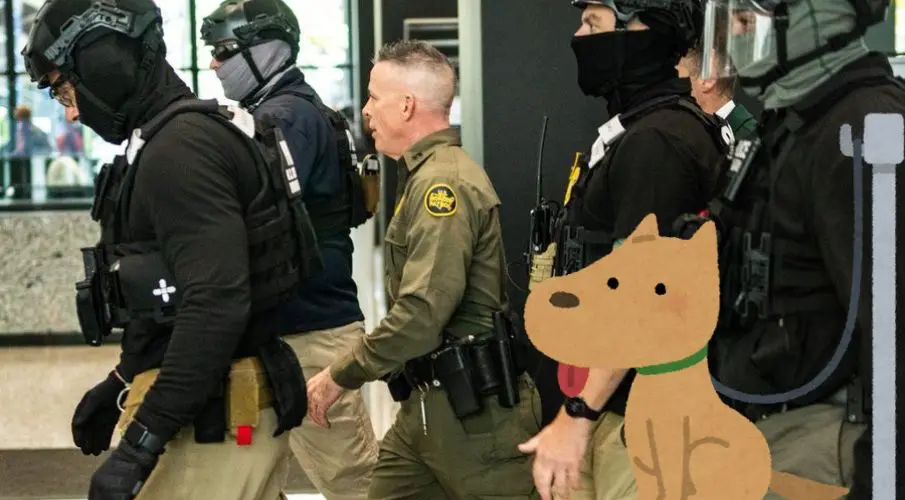It was a sentence as simple as it was humbling. “Yes, Ma’am,” said Gregory Bovino, the burly head of the U.S. Border Patrol in El Centro, California, every time Judge Sara Ellis made a new demand. “Yes, Ma’am” – into these two words shrank, on that day, the power of a man who in recent weeks had turned Chicago into a laboratory of authoritarian law enforcement. For the first time in the recent history of the United States, a federal judge has required a senior Border Patrol official to answer to her every evening. No press conference, no administrative report – but a personal meeting at 6 p.m., daily, until further notice. Ellis wants to know how Bovino’s agents act, whether they abide by law and Constitution – and whether they understand what has been happening in Chicago for weeks: a city under siege, led by men in green uniforms who believe that patriotism begins with tear gas.

More than 1,800 people have been arrested since September. The footage that went around the world showed streets shrouded in chemical mist, children with tear-filled eyes, reporters with their hands raised. The official explanation was: an operation against illegal migration. But the reality was different. The raids also targeted citizens, protesters, bystanders – people whose only mistake was being on the street at the wrong time.

Judge Ellis’s patience had run out on Tuesday. Within minutes in the courtroom, she made it clear she would not be fobbed off with bureaucratic phrases. “My role is not to tell you that you cannot enforce laws validly passed by Congress,” she said. “My role is simply to ensure that in the enforcement of those laws, the agents are acting in a manner consistent with the Constitution.” Then came the order: daily meetings. Complete reports. Body cameras. And an unmistakable tone that filled the room before Bovino could even respond. “Yes, Ma’am,” he said. And again. And again.
What prompted Ellis to take such drastic measures were images from the previous weekend. Children on their way to a Halloween parade in the city’s northwest, tears in their eyes after a smoke grenade had flown in their direction. Neighbors trying to protect the little ones while agents in green uniforms sealed off the sidewalk. “These children were tear-gassed on their way to a Halloween celebration,” Ellis said. “Their sense of safety was destroyed that Saturday – and it will take a long time to return, if ever.”

The tone was set. The judge ordered Bovino to submit all reports of use of force since September 2. He tried to explain that this was “physically impossible” – too much material, too many operations, too many agents. Ellis listened, waited a moment, and calmly repeated: “By Friday.”

Legal experts called the judge’s move “unprecedented.” Former federal prosecutor Phillip Turner said he had seen nothing like it in fifty years of courtroom experience. “This is real-time control – and exactly what was needed here.” Because Chicago is not El Paso, and the Border Patrol is not a police force. The agency’s presence inside the country has been legally questionable from the start. But Trump’s administration had turned the concept of “City Operations” into a new instrument – coordinated by Bovino, who had already led the controversial offensive in Los Angeles. There, agents had blown open doors, smashed windows, and dragged people out of cars. Now the same signature was visible in Chicago.

In Little Village, a predominantly Mexican neighborhood, Bovino was captured in a photo throwing tear gas into a crowd himself. A picture that lies in the court files – and one Ellis apparently knows well. She has now forbidden him to use “certain clearing techniques” against peaceful demonstrators and journalists. All agents must henceforth wear name badges and use body cameras.
“I suspect that now that it is clear where we stand and what I expect, we will see considerably less tear gas over the next week,” Ellis said dryly.
Bovino nodded. “Yes, Ma’am.”
Some in the room smiled. Others understood that this short sentence marked a turning point. It was the moment when an official who for weeks had felt untouchable suddenly faced a standard he could not control: the Constitution. And while outside the courthouse protesters held up their signs – “No tear gas on our streets,” “Hands off Chicago” – inside, the proceedings continued. The judge briefly noted what Bovino still had to submit. Then she closed the file. For the first time since the start of the offensive, someone who ordered tear gas was himself placed under supervision. Not by cameras, but by the law.
And again, Bovino said quietly: “Yes, Ma’am.”
Investigative journalism requires courage, conviction – and your support.
Please also strengthen our journalistic fight against right-wing populism and human rights violations. We do not want to finance ourselves through a paywall so that everyone can read our research – regardless of income or origin. Thank you very much!


Eine gute Richterin!
Was mich jetzt interessiert, hält er sich daran?
Es gab ja zu Halloween/den Abend davor erneut einen Tränengaseinsatz.
Ausgerechnet bei/in der Nähe einer Halloween parade für Kinder.